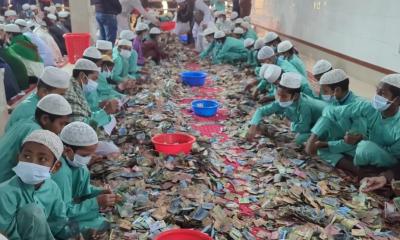In recent years, the `All Weather` road in Mithamin, Haor Upazila of Kishoreganj, Bangladesh, has emerged as a notable tourist attraction, thanks to its natural surroundings. However, the road has now found itself at the center of a heated debate on social media due to a massive Alpana drawing spanning 14 kilometers, stretching from the road`s zero point to Ashtagram, organized to celebrate Pahela Baishakh, the Bengali New Year.

The organizers tout it as the world`s longest Alpana drawing, aiming to showcase Bengal`s cultural heritage globally. Yet, concerns have been raised regarding the environmental impact of painting such large-scale Alpanas with chemical colors in ecologically sophisticated areas like Haor.
While some question whether this concern stems from genuine environmental consciousness or serves as a form of provocation, others ponder the motives behind choosing Haor for this grand display. Is it merely a reflection of festive fervor, or does it serve the branding interests of multinational companies backing the event?

Opponents argue that focusing solely on Alpana overlooks more pressing environmental issues, such as pollution from engine-driven boats and the destruction of native fish species in Haor due to practices like Chinese net fishing. Moreover, they point out the potential harm from chemical runoff during religious festivals in the coming months.
Amidst these debates, religious considerations have also surfaced, with some highlighting the Hindu significance of Alpana and idol worship on Pahela Baishakh, contrasting it with the absence of a specific Muslim religious festival on the day.
Environmentalists and experts have joined the fray, expressing dismay over the Alpana`s impact on the `All Weather` road`s surroundings. Dr. Shahriar Hossain, General Secretary of the Environment and Social Development Organization (ESDO), warned about the health risks posed by the volatile organic compounds (VOCs) present in the chemical colors used for the Alpana. He emphasized the potential air and water pollution, particularly harmful to the aquatic ecosystem of Haor.

Dr. Shahriar Hossain further highlighted the potential health hazards associated with the Alpana colors, emphasizing that these chemicals could enter the human body through various means, including ingestion via contaminated fish and absorption through the skin. He warned against the use of these toxic colors, which contain harmful substances like acrylate polymer and XPO polymer, capable of causing skin damage and spreading diseases upon contact.
"The colors used in this Alpana usually contain various types of harmful chemicals," he cautioned. "If these chemicals mix with water, they can enter the body through the skin pores, leading to various health issues. Moreover, the pollution doesn`t stop at air and water; it extends to the soil, posing further risks to the ecosystem."
He underscored the long-term health implications, stating, "These colors will enter the human body in various ways and spread various diseases. Regardless of whether the paint is water or oil-based, it contains organic contaminants that can result in complex health problems, especially for vulnerable groups like children and the elderly."
Echoing similar concerns, Professor Ahmad Kamruzzaman Majumdar, an expert in environment, climate, and air quality, condemned the use of chemical colors in festivities. In a Facebook post, he described the practice as a "festival of killing nature" and urged an immediate halt to such environmentally destructive activities.

Sheikh Moniruzzaman Liton, an artist involved in the Haor Alpana project from its inception, defended the use of colors, stating that they have personally experienced no harm despite prolonged exposure. He clarified that the colors used are water-based, containing minimal chemicals and more clay content, akin to household paints. He questioned why similar colors used in homes do not cause harm and criticized the controversy surrounding the initiative as an attempt to undermine positive efforts to preserve cultural traditions.
Russell Rana, an art teacher at Jagannath University, acknowledged the significance of the Guinness World Record-setting Alpana but emphasized that environmental harm contradicts the essence of artistic endeavors. He stressed the need for aligning artistic practices with environmental consciousness, cautioning against actions that compromise ecological integrity in the name of art.
Highlighting the lack of awareness regarding the toxicity of colors in Bangladesh, Dr. Shahriar Hossain lamented the absence of regulatory measures to ensure the safety of such products. He urged for stringent checks on the toxicity of colors used in cultural events and advocated for raising public awareness about their adverse effects on both the environment and human health. Additionally, he called upon the government to resist initiatives that pose environmental risks.




-20251226051932.jpeg)
-20251222051606.jpeg)





-20251227141313.jpeg)












-20251226062607.webp)












